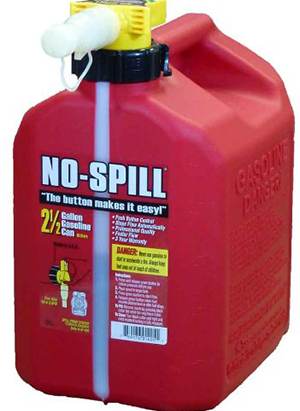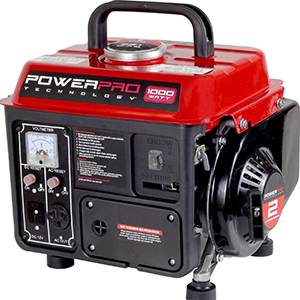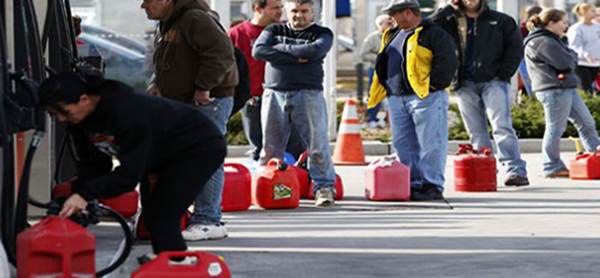A generator without gas is like a rifle without ammunition.
For this piece of machinery to be of any use to you outside of a very expensive and heavy paper weight, you need to have a plan for fuel storage. This is also the case if you don’t want to end up like millions of people each year who are unable to get gas after a natural emergency like Hurricane Sandy. A good fuel storage plan usually involves purchasing and properly treating a minimum amount of fuel to last you through whatever scenario you are planning for. This might be fuel for your generators, or enough gas to get you to your bug out location. It is easier to pre-purchase fuel and store it so that in the case of an emergency, you aren’t standing in line. There are a few things to consider when you are planning to store fuel long-term that we will cover below.
What type of container should you store fuel in?
Similar to having water on hand in an emergency; having a supply of fuel in containers that protect the fuel and are easy to carry is important. Could you store gas in thousand gallon tanks buried underground? Yes, and that is my dream scenario but for now I and I assume most others will have to settle for something a little more cost-effective and portable. There are many different types of fuel containers but for gas, the most common style is plastic and red in color with a built-in spout of some form. Kerosene containers are blue, Diesel is Yellow and it is important to follow this handy color convention so that you don’t accidentally pour regular gas in your kerosene heater and fry your eyebrows off or worse.
 You can get new fuel cans just about anywhere. Home Depot, WalMart, Lowes and any hardware store will have some options for you. Most of the new models at Walmart near me are from a company called Scepter and have a new type of nozzle which is probably the result of stupid legislation that doesn’t work well at all. The nozzle requires you to press two tabs and pull them into a position for the fuel to dispense. This doesn’t work very well and the fuel doesn’t come out smoothly. I don’t think this is necessarily Scepter’s fault and they are probably only doing what is required from government regulations.
You can get new fuel cans just about anywhere. Home Depot, WalMart, Lowes and any hardware store will have some options for you. Most of the new models at Walmart near me are from a company called Scepter and have a new type of nozzle which is probably the result of stupid legislation that doesn’t work well at all. The nozzle requires you to press two tabs and pull them into a position for the fuel to dispense. This doesn’t work very well and the fuel doesn’t come out smoothly. I don’t think this is necessarily Scepter’s fault and they are probably only doing what is required from government regulations.
You can also pick fuel cans up at yard-sales or salvage companies. There is a salvage company down the road from me that routinely has perfectly good fuel cans for very cheap with the old goose neck spouts. These are much superior in my opinion and if you are going to be pouring fuel out of a heavy can into a small hole I would recommend getting a good goose-neck or buying an older can. I have several of the new cans full of gas in my shed and a couple of older ones. If I need to pour anything out, I will use what is in the old style cans first and then pour my gas from the new cans into the old cans. It is just easier for me that way.
Regardless of whether you have a new or old can, the place you store your fuel should be as airtight as possible. You don’t want fumes leaking into the area you have your fuel stored and gasoline evaporates quickly when exposed to air.
Using Fuel Additives for long-term fuel storage
Gas loses its potency over time and this also applies to Diesel and Kerosene. Diesel for example if stored at lower than 70 degrees will last about 12 months without any additives provided it is kept in a sealed container. If your temperatures are much above 70 that time slips by 50% to 6 months.
As diesel gets older a fine sediment and gum forms in the diesel brought about by the reaction of diesel components with oxygen from the air. The fine sediment and gum will block fuel filters, leading to fuel starvation and the engine stopping. Frequent filter changes are then required to keep the engine going. The gums and sediments do not burn in the engine very well and can lead to carbon and soot deposits on injectors and other combustion surfaces.
Now, what can we do to prevent issues like this and protect our fuel because you don’t want to be trying to outrun the mutant zombie bikers from Mars and have your engine stop? Additives. There are two main additives that I have run across, STA-BIL and PRI-G. PRI has several lines of additives and the –G stands for gasoline. They also have PRI-D for diesel. PRI additives are designed to be added to your fuel on a yearly basis to maintain the fuel in the best condition possible and they even claim that if your fuel has aged already, just adding PRI-G has proven to restore the fuel to “refinery-fresh conditions”. I would rather not test that out but PRI-G does have a decent reputation.
 STA-BIL is one that I have personally used and does pretty much the same thing as PRI-G in terms of conditioning your fuel to last a lot longer in storage than it would without treatment. The instructions are simple, just dump the required amount in with your fuel and Voila! You should be able to safe storing fuel for at least a year with no adverse affects. I pour in the additive first and then the gas so that it is mixed as thoroughly as possible.
STA-BIL is one that I have personally used and does pretty much the same thing as PRI-G in terms of conditioning your fuel to last a lot longer in storage than it would without treatment. The instructions are simple, just dump the required amount in with your fuel and Voila! You should be able to safe storing fuel for at least a year with no adverse affects. I pour in the additive first and then the gas so that it is mixed as thoroughly as possible.
How Much and Where do I store my fuel?
Can you ever have too much fuel? I don’t know that you can in a real emergency. If you are unable to get to the gas station or there are rations at the pump you can never have too much. Would 500 gallons be enough? It really depends. If you have a minor power outage that lasts a few days, then you wouldn’t need that much gas at all. If we have the end of the world and there are no gas stations anymore, that 500 gallons is going to be a huge help, but it won’t last forever.
Related: How to Create a Vehicle Emergency Kit
What I think is a good baseline takes into consideration the 80/20 rule. What is the likelihood that you will need this fuel for? For most people I think storing fuel for a bug out vehicle or a generator is the most common scenario to plan for. For your car, I would plan on storing as much gas as you need to get you to your bugout location and add 50% to that. So, if you needed 2 tanks of gas to get you to your retreat and your tank held 20 gallons, I would store 60 gallons of treated fuel. This way if for some reason the grid goes down, the SHTF and zombies are walking all over the gas station parking lots, you should have plenty to get you there.
For a generator, I think you have to look at what you plan to run and how long you plan to run it. 15 gallons would last me about a week as long as I was using the generator for necessities only. Of course it depends on the time of year but that is an average. Everyone should have at least one can of gas stored for emergencies but I like to store a minimum of one tank of gas for my car which is roughly 17 gallons and another 10 for the generator.
Fuel should be stored in a clean, preferably cool place away from where you live. Don’t store fuel in your house if possible because that is an accident waiting to happen. If my shed blew up I would be a lot less concerned than if my house blew up.
This article was first posted on The Prepper Journal.
You may also like:
 How to Build an EMP Emergency Car Bag
How to Build an EMP Emergency Car Bag
H2O Dynamo – The Device That Turn Air Into Water (Video)
7 Actions to Take Immediately Following an EMP Strike
5 Best Countries To Move To Before SHTF
10 Things to Have Ready before the Huge EMP!!!















I think propane is a better fuel for long term storage. Does not require stabilizers. It can be use for generator, lights, refrigeration….For my use several 1,000 gallon tanks buried in the back 40 will last my homestaed for many years
what a nutcase ,,, writing the article, you are right propene is a much better choice,,,, when SHTF you will not want to use a generator this will give your location away,,,,
The article was surely written for the normal prepper in mind and for those that don’t have the luxury of having a “back 40” to bury those 1000 gal propane tanks, AND generators can be run quite quietly by using insulation and sound proofing for those that don’t think before they type. That said, putting in an old “root cellar” or home made storm shelter like those seen in the movies with the old (or new) double steel doors (preferred over wooden doors) would be a good place to store your gas. If you have neighbors that live close though, I’d make sure and lie to them and let them know it’s for your old garage junk that you just can’t part with yet and let them watch you carry something down there that has ABSOLUTELY no use for them in a SHTF scenario and place the gas cans BEHIND the junk and maybe cover them with an old blanket or thrown out moving pad from a moving company. Just make sure that the cellar is water proof and the doors are locked using a high security padlock. Decent locks usually sell for about $20 to $40 for good ones that can’t be burnt or picked.
On new EPA fue cans with the ‘glug-glug” spouts–simply take a small self tapping screw and drill in top rear–if using in lawn mower leave screw in , but if a vehicle, take screw out and it runs like old gas cans
I store gas …. but make darn sure it has no ethanol in it. Anyone want to buy 5 chainsaws cheap? They were victims of ethanol – gotta love government mandates!
Hell Farmer I haven’t seen fuel without ethanol in years
You can find it, but it takes some looking. I was actually able to find 2 places where I live that carry it, but be ready to pay for it. Cost almost an extra buck a gallon.
Yeah, ya just have to really “love” (hate) those liberal politicians that like to intrude on everyone’s life and then try and exalt themselves and say “look what I did to make gas can safer”, and all the while not giving a “rats a*s” how much more expensive or troublesome they just made those NEW gas cans for everyone just because it makes them feel all warm & fuzzy and politically correct!!!
I’m pretty sure not everyone has a place, let alone the money to store 60 gal. of gas.So,what kind of advice, do you have that has a reality related to it?
Wayne. Not having the money to buy something for your existence is HOG WASH…. Start yesterday do without some things you don’t absolutely have to have. Be it a candy bar, a soda, new pants or shirt. Use less of what you already use. Use 5 drops of dish soap instead of 10. Turn the heat down on colder days or the Air off on hot days….. Save and spend wisely is very important. It could mean the difference in life or death.
Replacement fuel can nozzles can be purchased from our local tractor supply (http://ezpourspout.com/) They also have vent fittings for them.
If you can get a hold of a hot water heater that doesn’t leak or rusted out in any way (one with a bad heating element for example), place it in a safe place on top of cider blocks or other sturdy structure. Drive a grounding rod into the earth and ground the heater to it. Ensure the tank is empty. Replace the drain plug on the bottom of the tank with a ball valve. Remove the cold water pipe on top of the tank. Replace the pipe with a half inch or 3/4 pvc pipe long enough to hold a long nozzle funnel. Use 5 gallon gas cans and fill the water tank with gas. Flush the bottom of the tank by flushing a quart or so of gas through the bottom ball valve. Add stabilizer for long term storage. Loosely thread a plug onto the hot water outlet on top of the tank. This will allow it to vent if pressure were to build up in the tank. I have used this type of storage for 3 years without issue. Each spring I use the gas to run my riding mower, and I top it off whenever, and again before winter. I wouldn’t recommend this in a suburban area, but if you have a bit of property, it works great. Place it under a covered structure or someplace protected from the weather. Use a step ladder when filling it.
Many municipalities and other local governments have gasoline storage limits. If you want to be lawfully compliant, check to see what your local government’s regulations are.
While I certainly would not advocate flouting local laws, there is one further caveat. Check your homeowner’s insurance policy to see if there are restrictions on fuel or flammables storage. You may not find it in your policy. You may have to check with your agent. If there are restrictions, don’t take his word for what they say, ask him to forward you the written restrictions so you can see for yourself what they are. I searched my policy for worker’s compensation terms. They weren’t in the policy sent to me each year. When I called my agent she tried to tell me what they were. I had her send me the written terms. I was very surprised at how limited the worker’s comp coverage was and most importantly what it didn’t cover. There was a steep learning curve there.
Some generators like the one I have is a dual fuel generator and will use gas or propane. I like running it on propane for several reasons, one is burning propane is cleaner and creates less carbon monoxide. Second is it is easier to store and use propane than gas and will last longer in storage without having to think about using any additives to preserve it. Lastly, a 20lb. tank of propane will run my generator about as long as ten gallons of gas but is about half the size of two five gallon gas containers.
The most optimal fuel for long-term storage is by far, LP/propane gas. This fuel does NOT deteriorate over time. Properly stored LP is only limited by the integrity of the storage container as the fuel itself will last many hundreds of years. In such cases the only limiting factors are whether or not the LP tank would rust through or become damaged by outside cataclysm.
PLAN AHEAD. far ahead…..!
Location is important, good neighbors are important… some locations have free natural gas…. some locations have good neighbors and natural barriers to deter the bad ones…..some locations have flowing wells for unlimited water..some locations have natural food sources…. look diligently, I takes time and very few realtors are knowledgable! !